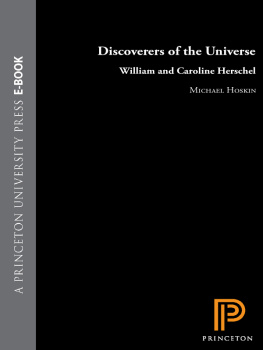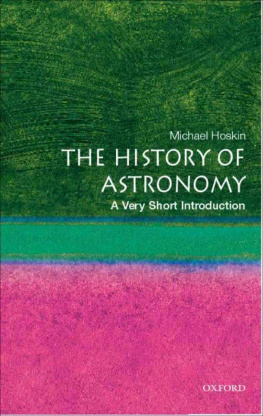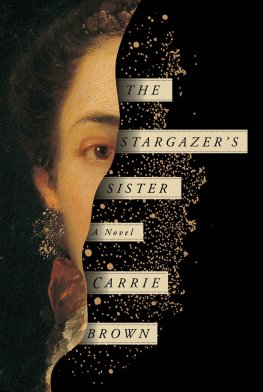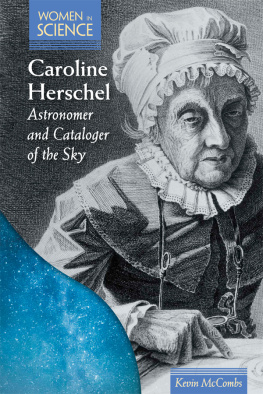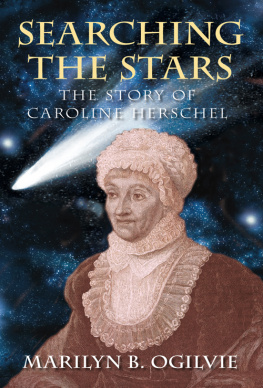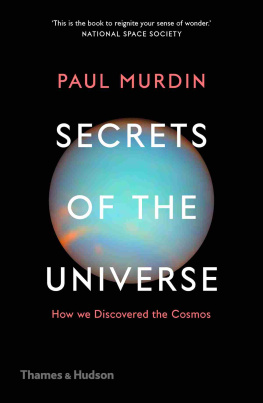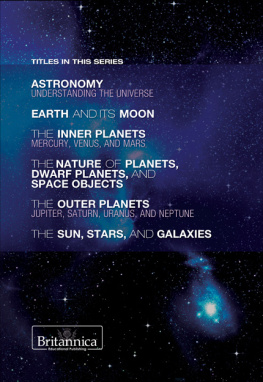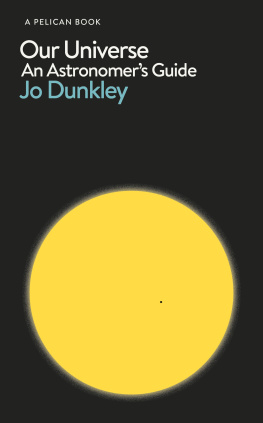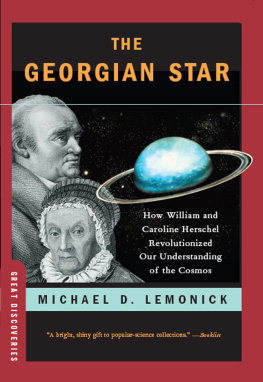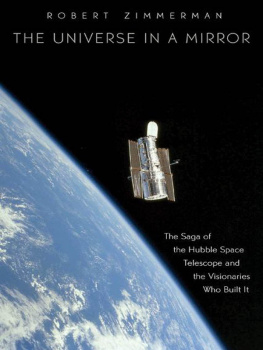BL | British Library |
Burney | Diary & Letters of Madame D'Arblay [Fanny Burney], ed. Charlotte Barrett (6 vol., London, 1905 |
CHA | Caroline Herschel's Autobiographies, ed. Michael Hoskin (Cambridge, 2003) |
Chronicle | The Herschel Chronicle: The Life-story of William Herschel and his Sister Caroline Herschel, ed. Constance A. Lubbock (Cambridge, 1933) |
Crowe | M. J. Crowe et al., eds., A Calendar of the Correspondence of Sir John Herschel (Cambridge, 1998) |
Hanover | Michael Hoskin, The Herschels of Hanover (Cambridge, 2007) |
HFA | Herschel Family Archives (private collection) |
JHA | Journal for the History of Astronomy |
Memoir | Memoir and Correspondence of Caroline Herschel, by Mrs. John Herschel, 2nd ed. (London, 1879) |
Memorandums | Memorandums from which an historical account of my life may be drawn, by William Herschel, Royal Astronomical Society, The Herschel Archive, W.7/8 |
Partnership | The Herschel Partnership: As Viewed by Caroline, by Michael Hoskin (Cambridge, 2003) |
PT | Philosophical Transactions of the Royal Society |
RAS | Royal Astronomical Society, The Herschel Archive |
WH | William Herschel |
The manuscripts of William, Caroline and John Herschel that are held by the Royal Astronomical Society are listed in J. A. Bennett, Catalogue of Archives and Manuscripts of the Royal Astronomical Society, Memoirs of the Royal Astronomical Society, 85 (1978). William Herschel carefully preserved incoming letters, and these are in RAS W.1/13; his book of outgoing letters is RAS W.1/1. All are individually listed by Bennett. Most letters between members of the family are still in the HFA, except those from Caroline in Hanover in her old age, which are in the British Library, Egerton 3761 and 3762.
Bibliographic Essay
The published works of William Herschel, with one minor exception, appeared in the Royal Society's Philosophical Transactions. They were assembled, together with the text of the many unpublished papers that William read to the Bath Philosophical Society, by the indefatigable J. L. E. Dreyer and published in two quarto volumes with the title The Scientific Papers of Sir William Herschel (London, 1912). Dreyer supplies a lengthy introduction that is all the more valuable in being by an experienced astronomical observer and skilled historian who had privileged access to Herschel manuscripts.
The bulk of the scientific manuscripts of William, Caroline, and John were donated to the Royal Astronomical Society, which has made the entire collection available worldwide in the form of inexpensive CDs and DVDs. Other important holdings, especially of the papers of John, are in the library of the Royal Society. Unfortunately other family papers, mostly of secondary interest, were dispersed at auction in 1958, but microfilms of those exported from the United Kingdom are in the British Library. A small number of papers remain with the family, who are most generous in allowing access to them.
Caroline's diaries and letters are extensively cited in Memoir and Correspondence of Caroline Herschel, by Mrs. John Herschel, 2nd ed. (London, 1879). A granddaughter of William also drew extensively on family papers for her admirable The Herschel Chronicle: The Life-story of William Herschel and his Sister Caroline Herschel, ed. Constance A. Lubbock (Cambridge, 1933); this has been reprinted by the William Herschel Society, Bath, UK. Lady Lubbock was elderly when she compiled her book, and the editor of Cambridge University Press was ruthless with it, omitting extensive sections. Fortunately the original typescript is in the possession of the William Herschel Society.
Caroline wrote two autobiographies, the second when she was in her nineties. Both are incomplete but they are invaluable sources for both her life and William's: Caroline Herschel's Autobiographies, ed. Michael Hoskin (Cambridge, 2003).
There are many popular and semipopular discussions of William and Caroline's lives and scientific work, but William Herschel: Explorer of the Heavens, by J. B. Sidgwick (London, 1953) retains its value. The inquirer after specific aspects of William's work will do well to start with Angus Armitage's methodical William Herschel (London, 1962).
The authoritative account of William's work as a telescope builder is J. A. Bennett, 'On the Power of Penetrating into Space': The Telescopes of William Herschel, Journal for the History of Astronomy, 7 (1976), 75108. William's principal theoretical papers in astronomy are reprinted with discussion in William Herschel and the Construction of the Heavens, by Michael A. Hoskin (London, 1963). An account of the partnership between William and Caroline is The Herschel Partnership: As Viewed by Caroline, by Michael Hoskin (Cambridge, 2003). For biographical essays on William's and Caroline's parents, and on each of their siblings, see The Herschels of Hanover, by Michael Hoskin (Cambridge, 2007).
An exhaustive analysis of the nebulae catalogues of William and John Herschel is to be found in Wolfgang Steinicke, Observing and Cataloguing Nebulae and Clusters: From Herschel to Dreyer's New General Catalogue (Cambridge, 2010).
1
17071773
A Musician's Odyssey
William's early life in Hanover had not been easy. Despite Isaac's absences for military service, he succeeded in fathering ten children; of the ten, four sons and two daughters survived into adulthood. Isaac was a poorly paid bandsman in the Hanoverian Guards; but he did what he could to supplement the basic education offered his children by the Garrison School, which consisted of reading, writing, and religious knowledge to the age of fourteen for both boys and girls, and for the boys, arithmetic. William later recorded how my father's great attachment to Music determined him to endeavour to make all his sons complete Musicians. As soon as the boys were old enough to hold a miniature violin, their lessons would begin.
Isaac, Anna, and the Founding of the Herschel Dynasty
Isaac himself was born in 1707, the youngest son of Abraham Herschel, a gardener who worked on an estate near Magdeburg, midway between Berlin and Hanover. Abraham was a remarkable man, for he was very fond of the art of arithmetic and writing as well as of drawing and music, and when he returned home after a hard day's manual work he would wash his hands, eat his supper, and then stretch his mind with pen and paper. Unfortunately Abraham died when Isaac was only eleven, and his widow could not afford to put her son through the usual apprenticeship as a gardener. But the resourceful boy taught himself the rudiments of gardening and eventually got a job tending the garden of an aristocratic widow. Yet he found himself irresistibly drawn to music. As a lad he had managed to buy a violin, and he had taught himself to play by ear. Now he used his wages to purchase an oboe and to pay for proper lessons.
When he was twenty-one, Isaac took his courage in both hands, quit his gardening job, and set off for Berlin to find a post as oboist, only to decide that what he was offered was very bad and slavish. Impressed by the young man's dedication, his surviving brother and their sister paid for him to have a year's musical tuition with an elderly Prussian band conductor. Eventually we find him in Brunswick, again looking for a post as oboistand again declining what he was offered, this time because it was too Prussian. Isaac next traveled to Hanover, where the electorwho was also King of Britainmaintained a corps of Guards with its own band. This time Isaac found the terms acceptable, and on August 7, 1731, he at last became a professional musician.

